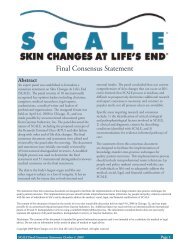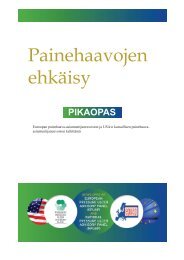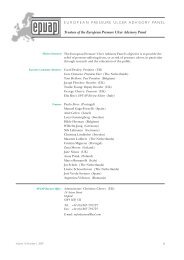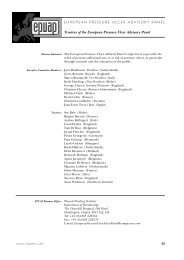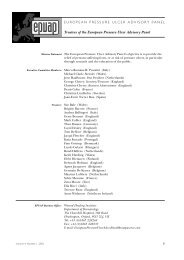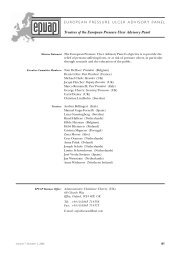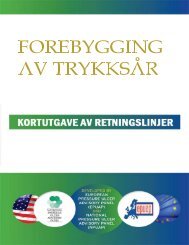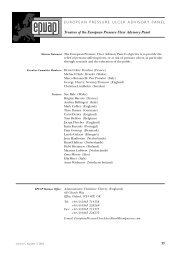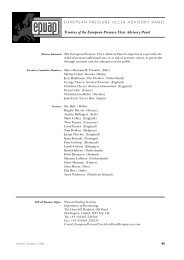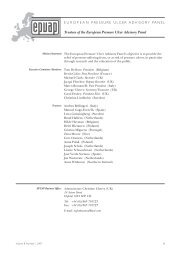Review 6.2 - European Pressure Ulcer Advisory Panel
Review 6.2 - European Pressure Ulcer Advisory Panel
Review 6.2 - European Pressure Ulcer Advisory Panel
You also want an ePaper? Increase the reach of your titles
YUMPU automatically turns print PDFs into web optimized ePapers that Google loves.
ABSTRACTS FROM THE 2ND WUWHS MEETING<br />
the <strong>European</strong> <strong>Pressure</strong> <strong>Ulcer</strong> <strong>Advisory</strong> <strong>Panel</strong>, the US Agency<br />
for Health Care Policy & Research and the UK National<br />
Institute for Clinical Excellence where each guideline was<br />
assessed by minimum of four reviewers.<br />
PRESSURE ULCERS 3 (SUPPORT SURFACE<br />
EFFECTIVENESS) CLINICAL EVALUATION OF<br />
SUPPORT SURFACES: A REVIEW<br />
N. Cullum (UK)<br />
A systematic review has been undertaken in order to establish<br />
the relative effectiveness of different pressure-relieving<br />
support surfaces in reducing the development of new pressure<br />
ulcers. Studies in any language, published or unpublished,<br />
in which participants were randomised, and which<br />
reported the incidence of new pressure ulcers as an outcome<br />
were eligible for inclusion. After a comprehensive<br />
search for studies, study selection and data extraction were<br />
undertaken by one reviewer and checked by a second. Individual<br />
study validity was appraised by two reviewers independently.<br />
41 eligible RCTs were identified. The validity of<br />
eligible studies was variable with only half providing sufficient<br />
information for us to judge that allocation to support<br />
surfaces was truly random. Blinded outcome assessment was<br />
used in 10 studies. Median sample size in individual studies<br />
was 80 (range 12 1166). Foam alternatives to the standard<br />
hospital foam mattress reduce the incidence of pressure<br />
ulcers in people at risk of developing pressure ulcers. The<br />
relative merits of alternating and constant low pressure<br />
devices, and of the different alternating pressure devices<br />
for pressure ulcer prevention are unclear. These and other<br />
findings will be presented alongside an overview of the validity<br />
of trials in this area, and the methodological challenges<br />
associated with the evaluation of support surfaces.<br />
PRESSURE ULCERS 3 (SUPPORT SURFACE<br />
EFFECTIVENESS) MAINTAINING<br />
APPROPRIATE SKIN MOISTURE AND<br />
TEMPERATURE OF THE PATIENT: A<br />
BIOMEDICAL ENGINEERING OVERVIEW<br />
E. Flam, L.I. Raab (US)<br />
Excess moisture and over-heating weaken the skin. Excess<br />
moisture also increases friction and shear leading to greater<br />
damage from these forces. The skin of a patient can be more<br />
resistant to developing pressure ulcers if conditions that<br />
weaken it are controlled. The area of the patient’s skin in<br />
contact with the support surface is most susceptible to these<br />
adverse conditions. Low Air Loss therapy (LAL) is considered<br />
as a valuable means to help control these conditions.<br />
In effective LAL therapy, air flow from the cushions of the<br />
support surface removes the excess moisture and heat. From<br />
a Biomedical Engineering perspective, the design of an LAL<br />
system must take the following factors into account: the<br />
sources of excess moisture and temperature; the quantity<br />
of excess moisture produced; the elevation of the skin temperature;<br />
the air flow available for managing these excesses;<br />
and the ability of the support surface to effectively use the<br />
air flow to remove the excess moisture and heat. In this<br />
symposium section, the determination of these factors is<br />
detailed. An example is then provided to demonstrate how<br />
their interaction can result in an effective clinical outcome.<br />
PRESSURE ULCERS 4 (RISK ASSESSMENT) DO<br />
RISK ASSESSMENT TOOLS WORK<br />
B. Barrois (FR)<br />
<strong>Pressure</strong> ulcers occur on elderly and reduced mobility patients.<br />
Many studies choose pertinent risk factors and asses<br />
their validity. Using a validate tool is necessary. No strategy<br />
as allowed pressure ulcer abolition. Fiability No study is<br />
randomised. BRADEN scale is the most studied. It can be used<br />
for children in USI (Curley). It must be associated with understanding<br />
the clinical uses (Russel) and repeated<br />
(Pokorny) WATERLOW scale is specific for very old patients.<br />
NORTON scale is more specific than Waterlow for elderly.<br />
Limits BRADEN scale Cut-off s difficult to determine. Waters).<br />
Predictive factors are: very old woman, with cognitive and<br />
mobility reduction (Horn) WATERLOW scale Anthony showed<br />
than age is predictive but gender is not, without scientific<br />
proof for validity to each item. Four items: continence; skin<br />
aspect; mobility; and ability to transfers are valid. (Papanikolaou)<br />
NORTON scale Over evaluation appear in 64%. In palliative<br />
units, activity, mobility and age are predictive<br />
(Henoch) Specific factors appear for children (Samaniego)<br />
and smokers. For elderly using medics and institution entry<br />
(Baumgarten) are predictive indicators. Pain reduces<br />
motility and increase the risk (Reddy). Confusion, hypo<br />
albuminémia and bowel incontinence are significant<br />
(Reed). New tools OASIS asses risk level.<br />
Conclusion: Using an assessment tool for risk factors is useful.<br />
It is better than clinical feeling but it is improved by<br />
clinical assessment. Every scale as good sensitivity and poor<br />
specificity. The new idea from 2000 is assessment of predictive<br />
factors. No tool is actually very efficient.<br />
PRESSURE ULCERS 4 (RISK ASSESSMENT)<br />
WHAT ARE RISK FACTORS: SENSE OR<br />
NONSENSE OF PRESSURE ULCER RISK<br />
ASSESSMENT SCALES<br />
T. Defloor (BE)<br />
Risk assessment scales are considered to be essential tools<br />
for providing pressure ulcer prevention care. There is a wide<br />
consensus that prevention plans should include mechanisms<br />
for predicting which patients are more likely to develop<br />
pressure ulcers and that interventions should be directed<br />
to the vulnerable. Risk assessment tools are used to help<br />
identifying those patient who are at risk. In 1962 the first<br />
pressure ulcer risk assessment scale—the Norton scale—<br />
was designed and tested. Since the 1980’s several new risk<br />
assessment scales have been developed (Braden, Waterlow,<br />
Knoll, CBO, etc.). The currently available risk assessment<br />
scales are only of limited value. It may be expected that<br />
many patients are falsely identified as at risk or not at risk.<br />
Sensitivity and specificity are commonly used to evaluate<br />
the validity of risk assessment scales. The use of intermediate<br />
preventive measures decreases the risk of pressure ulcers<br />
development and means that sensitivity and specificity<br />
criteria are not the most appropriate method to validate<br />
Volume 6, Number 2, 2004 51



